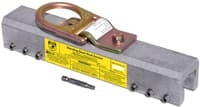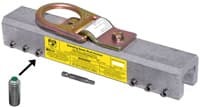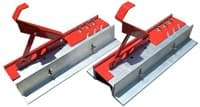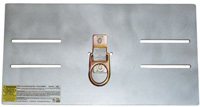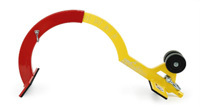Fall Protection Strategies For JD Metals Roofs
Posted by Howie Scarboro - CEO Fall Protection Distributors, LLC on Apr 11th 2025
See the Roof Anchor Compatibility Chart for JD Metals Standing Seam Metal Roof Panels.

Who Is JD Metals?
JD Metals has been serving the construction industry since 1994. Operating from its headquarters in the Tri-Cities region of Northeast Tennessee, the company provides metal roofing and building products to customers across Tennessee, the Carolinas, Virginia, and parts of Georgia. Over the years, JD Metals has evolved from a local manufacturer to a regional resource, offering in-house manufacturing capabilities and a network of dealers that extend its reach.
Focusing on linking quality with service, JD Metals delivers reliable solutions and knowledgeable support for metal roofing, siding, and framing systems. Whether you are a homeowner seeking a new roof or a contractor working on a large commercial project, JD Metals offers a variety of products designed to meet modern construction standards. From standing seam panels to innovative framing packages, the company combines durability with cost-effective design, underscoring its longstanding commitment to customer satisfaction.

Why Compatible Anchors Are Critical for Standing Seam Roofs
Standing seam roofing has a clean appearance and watertight design. With its raised seams protecting and concealing fasteners, this style of metal roof resists leaks and extends the life of the panels. However, installing fall protection anchors requires specific considerations because the surface remains intentionally free of visible fasteners and penetrations.
Traditional anchors typically rely on screws or bolts that penetrate the roof, which can compromise the structural integrity of a standing seam system. Punctures may lead to leaks, corrosion, or other weaknesses. Instead, non-penetrating seam anchors are explicitly made for standing seam clamps onto the raised seams without creating holes in the metal. This feature maintains the roof's ability to expand and contract naturally. It helps preserve any warranty protections that hinge on proper installation.
Safety regulations recommend using anchors specifically tested and rated for standing seam roofs, as they provide a secure connection that maintenance workers and emergency responders can trust. Ultimately, the right anchoring system offers peace of mind and long-term cost savings, helping property owners maximize their investment in a standing seam roof.
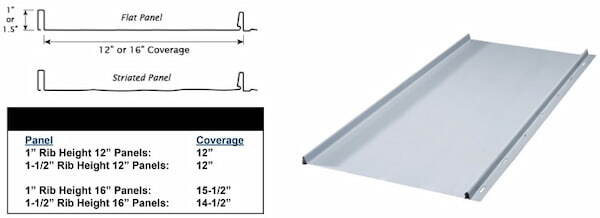
JD Metals 1-Inch Nailstrip Panels
The 1-inch Nailstrip Standing Seam metal roofing panel from JD Metals offers a modern, streamlined look that enhances a variety of architectural styles. It comes in 12-inch or 16-inch coverage widths (depending on the rib profile). It employs a concealed fastener system that places the attachment points within a narrow nail strip. This ability eliminates visible screws, creates a sleek finish, and reduces the likelihood of water infiltration.
Manufactured from high-grade steel in 29, 26, or 24-gauge thicknesses, the 1-inch Nailstrip panel performs reliably in various climates and conditions. Customers can choose from multiple Sherwin-Williams finishes, such as the WeatherXL line for vibrant and lasting color or Fluropon PVDF in select 24-gauge colors for extra weather resistance. A textured Crinkle finish and an aluminum option add further versatility. Designed for a minimum slope of 3:12, this panel installs over solid substrates with underlayment for robust, long-term performance.
Fall Protection For 1-inch Nailstrip Panels
For 24-gauge steel panels, three SSRA components work together to provide reliable tie-off points, walk-board access, and horizontal lifeline attachments without penetrating the metal surface. The foundation is the SSRA1 Seam Anchor, which clamps onto the raised seam instead of requiring screws. The SSRA2 Adjustable Roof Jack Adapters mount on top of the SSRA1 anchors to support 10-foot wooden walkboards. Once secured, these walkboards create a stable platform for moving freely along the roof while staying tied off through the SSRA1 anchor points. To accommodate a horizontal lifeline, the SSRA3 Anchor Plates get installed on top of two SSRA1 anchors, establishing a secure anchorage for a temporary 100-foot lifeline. Because all three products clamp directly onto the standing seam ribs, they preserve the roof's watertight integrity and protect any warranty coverage that applies to the metal panels. See the Roof Anchor Compatibility Chart for JD Metals 1-inch Nailstrip Standing Seam Metal Roof Panels.
For substrates and gauges other than 24-gauge steel, Ridge Pro Steep Assist offers a versatile fall protection solution for roof slopes ranging from 6/12 to 12/12. The device hooks over the roof's peak and allows continuous tie-off without relying on penetrations in the metal. This accessibility is especially valuable for maintaining safety on steep surfaces. By matching the right fall protection system to the panel gauge and roof design, property owners and contractors can safeguard workers while preserving the functional and aesthetic advantages of standing seam metal roofing.
JD Metals 1.5-Inch Nailstrip Panels
The 1.5-inch Nailstrip Standing Seam metal roofing panel from JD Metals combines a bold, modern aesthetic with the reliable performance demanded in residential and commercial construction. Its 1.5-inch rib height creates a pronounced, eye-catching profile. At the same time, the concealed fastener system—complete with an optional nail strip—ensures a refined finish free of visible screws. This panel is available in 12-inch or 16-inch coverage widths (depending on rib height). It is high-grade steel in 29, 26, or 24-gauge thicknesses. The 1.5-inch Nailstrip panel stands up to the elements for long-lasting appeal, backed by JD Metals' warranties on painted steel and Galvalume. See the Roof Anchor Compatibility Chart for JD Metals 1.5-inch Nailstrip Standing Seam Metal Roof Panels.
Customers can choose from an assortment of finishes by Sherwin-Williams, including the durable WeatherXL finish in more than 20 vibrant colors for 26-gauge steel and select shades in 24-gauge, as well as the advanced Fluropon PVDF coating for outstanding weather resistance in specific 24-gauge colors. Those seeking a textured surface can opt for the Crinkle finish, while aluminum offers more flexibility. Designed for installation over solid substrates with underlayment, the 1.5-inch Nailstrip panel is recommended for a minimum slope of 3:12, making it stylish and practical for a wide range of roofing applications.
Fall Protection For 1.5-inch Nailstrip Panels
Preserving the clean profile of standing seam roofing requires specialized fall protection that avoids penetrations in the metal surface. For 24-gauge steel versions of the 1.5-inch Nailstrip panel, SSRA1 Seam Anchors form the cornerstone of a non-intrusive system. These anchors clamp directly to the raised seam, eliminating the need for screws or bolts that could compromise the roof's watertight integrity.
Building on that foundation, the SSRA2 Adjustable Roof Jack Adapters attach to each SSRA1 anchor secure 10-foot wooden walkboards. This setup allows workers to traverse the roof with added stability and convenience, all while remaining safely tied off at the anchor points. When a longer span of fall protection is needed, the SSRA3 Anchor Plates are installed across two SSRA1 anchors to create a robust tie-off point for a temporary 100-foot horizontal lifeline. Because each product clamps to the seam rather than piercing it, the roof remains intact, and any applicable warranties remain valid.
In instances where the roofing material or gauge falls outside of 24-gauge steel, Ridge Pro Steep Assist provides a flexible solution for slopes ranging from 6/12 to 12/12. This device rests over the roof peak without penetrating the metal, allowing workers to maintain 100% tie-off and move safely during installation, inspections, or repairs on steeper roofs. By matching the proper fall protection approach to your specific panel design and gauge, you can ensure worker safety and the integrity of your standing seam system for years to come.
Standing Seam Roof Anchor Compatibility for JD Metals
| 1-Inch Nailstrip 24 ga. | 1.5-inch Nailstrip 24 ga. | |
|---|---|---|
| YES | YES | |
| YES | YES | |
| YES | YES | |
| YES | YES | |
| YES | YES |
Contact Us For More Information
For further details on roofing solutions and fall protection systems, contact us at 863-703-4522 or www.StandingSeamRoofAnchor.com. Let's work together to make your roofing projects safe, beautiful, and built to last. For more safety tips, check out OSHA's 48-page fall protection manual. Once you have determined the most suitable anchors for your roof system, download our free Anchor Inspection Form.
Safety Tips For Standing Seam Roofs
Use Specialized Anchor Systems for Standing Seam Roofs
Standing seam roofs demand a unique approach to fall protection. Unlike traditional anchors that require drilling and can lead to costly leaks or warranty issues, seam-mounted anchor systems clamp directly onto the panel ribs without penetrating the surface. This preserves the roof’s structural integrity and provides secure, reliable tie-off points for workers. Using anchors designed specifically for standing seam applications is critical for protecting both people and property.
Ensure Proper Footwear for Stability
Every safe roofing job starts from the ground up—specifically with the right boots. Footwear with slip-resistant soles gives workers the grip they need to confidently move across slick or sloped metal surfaces. Good traction improves balance, reduces fatigue, and lowers the chance of dangerous slips, even on well-secured roofs. Without the right footwear, fall protection gear is only half as effective.
Promote a Culture of Safety
Creating a work environment where safety is the shared responsibility of every crew member leads to better outcomes across the board. Regular safety briefings, open communication about job site hazards, and ongoing training build a culture of accountability and care. When safety becomes part of the everyday routine, workers feel empowered to speak up, follow procedures, and look out for one another.
Prioritize Ladder Safety Training
Many fall incidents happen before workers even reach the roof. Proper ladder setup and usage is essential for safe access. Crews should be trained to inspect ladders before use, position them on level ground, and maintain three points of contact at all times. Following key practices like the 4-to-1 ratio for ladder angle placement can prevent accidents before the real work begins.
Equip Workers with High-Quality Safety Gear
The difference between a close call and a catastrophic injury often comes down to the quality of the gear. Workers should be equipped with OSHA-approved harnesses, lifelines, and lanyards that are appropriate for roofing environments. Comfortable, properly adjusted gear encourages consistent use and reduces the temptation to cut corners. When safety gear fits well and functions reliably, it becomes a natural part of the workday.
Encourage the Use of Trauma Straps
In the event of a fall, a worker suspended in a harness may experience suspension trauma if left hanging too long. Trauma straps provide a critical way to relieve pressure, promote circulation, and buy time while waiting for rescue. Teaching workers how to deploy these straps quickly can mean the difference between a successful recovery and serious medical complications.
Install Permanent Roof Anchor Systems
For buildings that require regular rooftop access, permanent anchors offer an efficient and code-compliant fall protection solution. These fixed tie-off points eliminate the need to set up temporary systems for every maintenance visit. Permanent anchors are especially valuable on commercial and industrial roofs, where long-term reliability and quick access are key to both productivity and safety.
Develop OSHA-Compliant Safety Plans
A successful roofing project begins with a thorough safety plan. This includes more than just a checklist—it involves clearly defined fall protection strategies, emergency procedures, and hazard assessments tailored to the job site. A well-crafted safety plan ensures every team member understands their responsibilities and promotes a safer, more efficient work environment from start to finish.
Set Up Protective Guardrail Barriers for Work Zones
Temporary or permanent guardrails are a straightforward way to prevent falls around roof edges, skylights, and other hazard zones. These barriers give workers a physical reminder of boundaries while allowing them to focus on the task at hand. Guardrails reduce mental strain, minimize edge-related incidents, and contribute to a safer overall workspace.
Consult Experts for Curved Metal Panels
Curved roofs present unique challenges that require specialized fall protection strategies. Off-the-shelf anchors may not provide the stability needed on curved surfaces, and improper installation can create serious risks. Before beginning work, consult safety professionals who understand the geometry and demands of curved metal systems. Expert input ensures that workers stay safe and the roof remains undamaged and code-compliant.
Disclaimer
The views, recommendations, and information presented in this blog are solely those of the author and do not necessarily reflect the opinions or positions of the featured panel manufacturer, its brands, subsidiaries, or parent companies. Customers are strongly encouraged to reach out directly to the roof panel manufacturer for inquiries regarding fall protection compatibility with their products and to address any potential warranty issues that may arise following the installation of our products.


